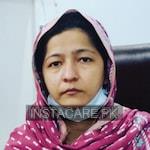Dyshidrotic Eczema - Symptoms, Risk factors and Treatment
Last Updated On Thursday, December 25, 2025
Dyshidrotic Eczema in Urdu
Dyshidrotic eczema، جسے dyshidrosis، foot-and-hand eczema، pompholyx، vesicular eczema، یا palmoplantar eczema بھی کہا جاتا ہے، ایک ایسی حالت ہے جس میں آپ کی جلد پر دردناک خارش والے سرخ چھالے ظاہر ہوتے ہیں، عام طور پر پاؤں کے تلووں، ہاتھوں کی ہتھیلیوں پر، انگلیوں کے کناروں، اور انگلیوں. اس کی صحیح وجہ معلوم نہیں ہے۔ لیکن ماہرین کا خیال ہے کہ یہ ان لوگوں میں زیادہ عام ہے جو ایکزیما کی دوسری اقسام کا شکار ہیں۔ اب تک اس کا کوئی علاج نہیں ہے۔ تاہم، ان کا انتظام موئسچرائزرز، ادویات، اور آپ کی حفظان صحت کو برقرار رکھتے ہوئے کیا جا سکتا ہے۔ اس کے علاوہ، ایک بار جب آپ درمیانی عمر میں داخل ہوتے ہیں، تو وہ ختم ہونے لگتے ہیں. عام طور پر، وہ تقریباً دو سے چار ہفتوں تک رہتے ہیں اور ان کا تعلق تناؤ اور موسمی الرجی سے ہوتا ہے۔
Dyshidrotic Eczema in English
Dyshidrotic eczema, also known as dyshidrosis, foot-and-hand eczema, pompholyx, vesicular eczema, or palmoplantar eczema, is a condition in which painful itchy red blisters appear on your skin, usually on soles of the feet, palms of the hands, edges of fingers, and toes. The exact cause for it is unknown. But experts believe it is more common in people who are prone to other types of eczema. Until now there is no such cure for it. However, they can be managed with moisturizers, medicines, and maintaining your hygiene. Moreover, once you enter into middle age, they start to taper off. Usually, they last for about two to four weeks and are related to stress and seasonal allergies.
Symptoms
The most common symptom of dyshidrotic eczema is painful blisters that usually appear on the soles of the feet, palms of the hands, edges of fingers, and toes. The blisters that appear on the edges are mostly filled with fluid.
At times, it can cause large blisters that are immensely painful and quite itchy. The blisters also cause your skin to flake out. The areas affected may become cracked and painful to touch. They may remain for up to three weeks and begin to dry. But the skin underneath can become red and tender for some time. Continuous scratching can cause your skin to thicken and become spongy. Usually, they appear in clusters. The other signs and symptoms of dyshidrotic eczema are;
- Sweaty skin around the blisters
- Nails that thicken and change colors
- Itching or a burning pain before blisters appear
- Blisters on the edges of your fingers, toes, palms, and soles of your feet
- Red, itchy, and cracked skin
The signs and symptoms of dyshidrotic eczema depend on severity. If it is mild it may not be so bothersome for you. But if it becomes severe, it may hinder in day to day activities like cooking, washing dishes, or writing. Scratching the blisters can make them more painful and make them infectious too, which in turn causes swelling, crusting, and pus in the blisters.
Causes
The exact cause for it is unknown. But experts believe it is more common in people who are prone to other types of eczema. Until now there is no such cure for it. However, they can be managed with moisturizers, medicines, and maintaining your hygiene. Moreover, once you enter into middle age, they start to taper off. Usually, they last for about two to four weeks and are related to stress and seasonal allergies. Other cause for it can be;
- Stress
- Prolonged contact with metals like nickel, cobalt, or chromium in your jewelry or job
- Sweaty or wet hands and feet
- Exposure to warm and humid weather
- Getting an HIV infection
- Getting treated with immunoglobulin
- Seasonal allergies like hay fever
People with other allergies are more prone to dyshidrotic eczema. It is not a contagious disease which means it does not spread through touch. However, if you get in contact with an infected lesion, you must wash your hands with antibacterial soap and water after that.
Treatment
Treatment for dyshidrotic eczema may involve;
- Light therapy
- Getting botulinum toxin that stops excessive sweating in your hands and feet and thus prevents blisters from growing
- Medicated ointments like that of tacrolimus or pimecrolimus that help calm the swelling and itching of the skin
- Draining the blisters- do not try it on your own. By doing that you can worsen eczema. Only healthcare providers would do that.
Conclusion
Dyshidrotic eczema, also known as dyshidrosis, foot-and-hand eczema, pompholyx, vesicular eczema, or palmoplantar eczema is a condition in which painful itchy red blisters appear on your skin, usually on soles of the feet, palms of the hands, edges of fingers, and toes. The exact cause for it is unknown. But experts believe it is more common in people who are prone to other types of eczema. Until now there is no such cure for it. However, they can be managed with moisturizers, medicines, and maintaining your hygiene.









